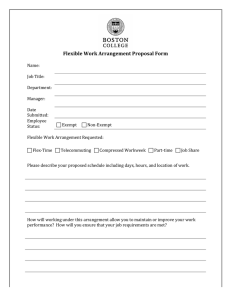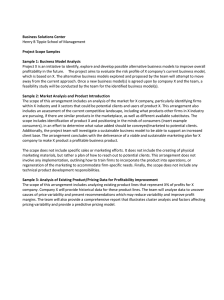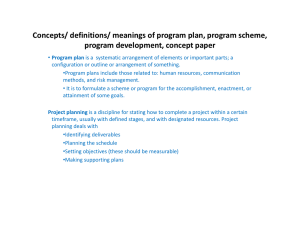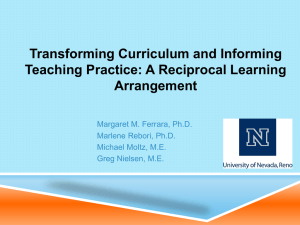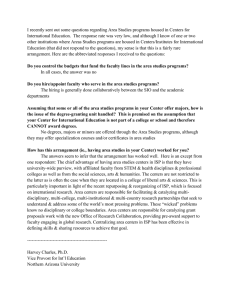Patterns & Problems Bridges in Mathematics Grade 4 Unit 7
advertisement
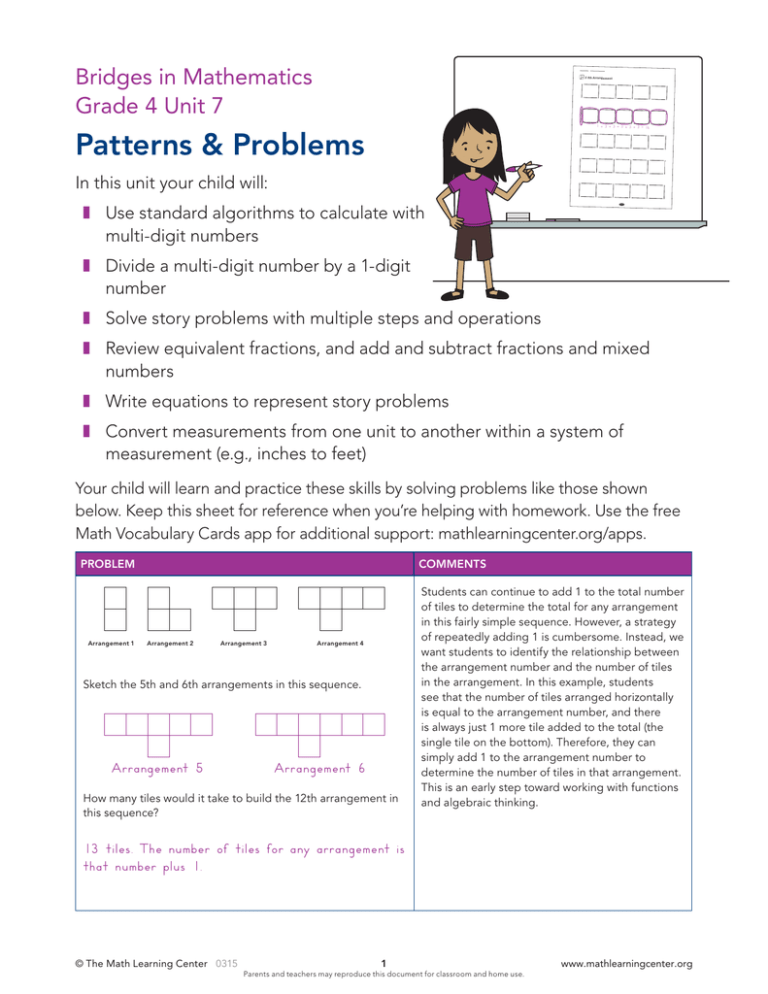
Bridges in Mathematics Grade 4 Unit 7 F fth Arrangement 1 + 3 + 3 + 3 + 3 + 3 = 16 Patterns & Problems In this unit your child will: ❚❚ Use standard algorithms to calculate with multi-digit numbers ❚❚ Divide a multi-digit number by a 1-digit number ❚❚ Solve story problems with multiple steps and operations ❚❚ Review equivalent fractions, and add and subtract fractions and mixed numbers ❚❚ Write equations to represent story problems ❚❚ Convert measurements from one unit to another within a system of measurement (e.g., inches to feet) Your child will learn and practice these skills by solving problems like those shown below. Keep this sheet for reference when you’re helping with homework. Use the free Math Vocabulary Cards app for additional support: mathlearningcenter.org/apps. PROBLEM Arrangement 1 COMMENTS Arrangement 2 Arrangement 3 Arrangement 4 Sketch the 5th and 6th arrangements in this sequence. Arrangement 5 Arrangement 6 How many tiles would it take to build the 12th arrangement in this sequence? Students can continue to add 1 to the total number of tiles to determine the total for any arrangement in this fairly simple sequence. However, a strategy of repeatedly adding 1 is cumbersome. Instead, we want students to identify the relationship between the arrangement number and the number of tiles in the arrangement. In this example, students see that the number of tiles arranged horizontally is equal to the arrangement number, and there is always just 1 more tile added to the total (the single tile on the bottom). Therefore, they can simply add 1 to the arrangement number to determine the number of tiles in that arrangement. This is an early step toward working with functions and algebraic thinking. 13 tiles. The number of tiles for any arrangement is that number plus 1. © The Math Learning Center 0315 1 Parents and teachers may reproduce this document for classroom and home use. www.mathlearningcenter.org Grade 4, Unit 7: Patterns & Problems PROBLEM COMMENTS Add parentheses to make the equation true. If performed from left to right, the operations produce a result of 16. ( ) 36 ÷ 3 + 6 – 2 = 2 36 ÷ 3 + 6 – 2 = 16 The parentheses are necessary to indicate that 3 + 6 should be done first. After that, students perform the division first and then the subtraction, according to order of operations. Solve this problem. Students are becoming fluent with the standard algorithm and should be able to use it to multiply multi-digit numbers. Some students will have other equally efficient and accurate strategies for solving problems like this one, as shown at left. 32 × 19 = _____ 32 × 20 = 640 640 – 32 = 608 32 × 19 288 320 608 Terrell’s aunt pays him to help with her yard work. She pays him $4 per hour. Terrell’s little sister helps him with the work sometimes. For her help, Terrell gives his little sister $10. Which expression shows how much money Terrell has left after paying his sister? (The letter h stands for the number of hours Terrell will work for his aunt.) 14 × h 4 + 10 × h 4 × h – 10 Students are eventually expected to write their own expressions to represent problem situations. Selecting an expression from a few choices is a step toward that skill. It requires students to think carefully about the relationships between the numbers in the problem. 6×h How much money will Terrell have after working 16 hours and paying his sister? Show all your work. 4 × 16 – 10 2 × 2 × 16 – 10 2 × 32 – 10 64 – 10 $54 FREQUENTLY ASKED QUESTIONS ABOUT UNIT 7 Q: Is it OK to let my child use a calculator to solve the problems in this homework? A: Calculators are very useful tools, and most adults use them to solve math problems at home and at work. We want fourth graders to become proficient with mental and paper-and-pencil methods for adding, subtracting, multiplying, and, eventually, dividing. To become proficient with those skills, they need practice, so for now, ask them to put away the calculators. © The Math Learning Center 0315 2 Parents and teachers may reproduce this document for classroom and home use. www.mathlearningcenter.org
